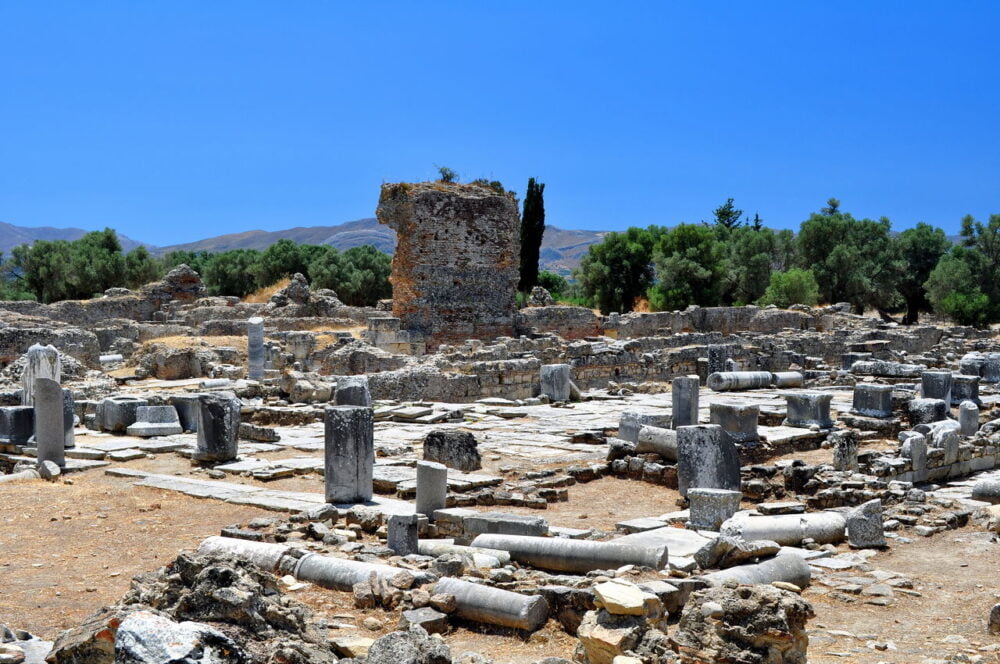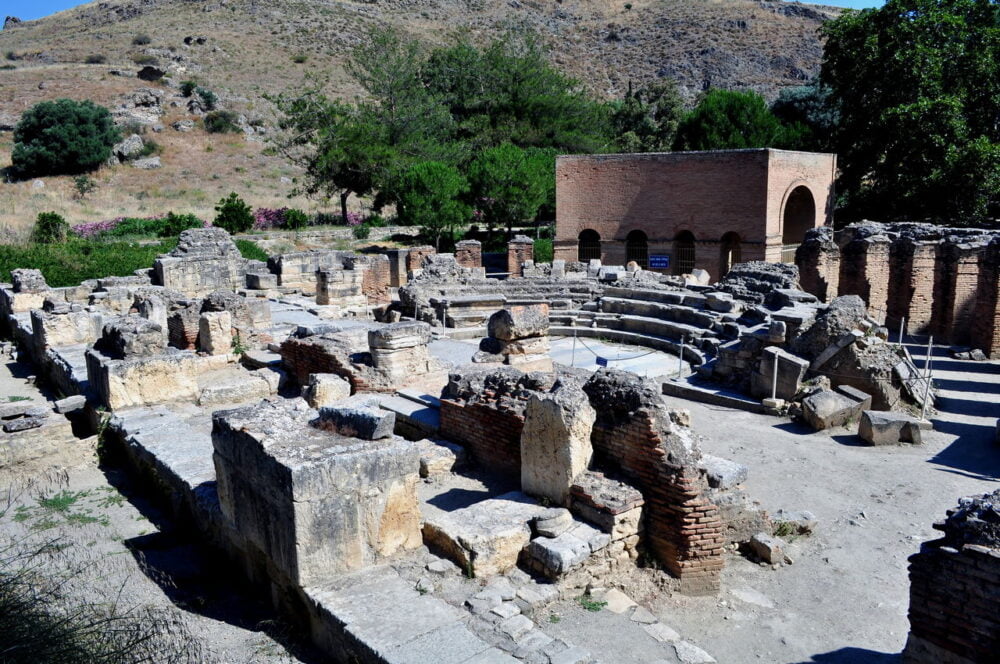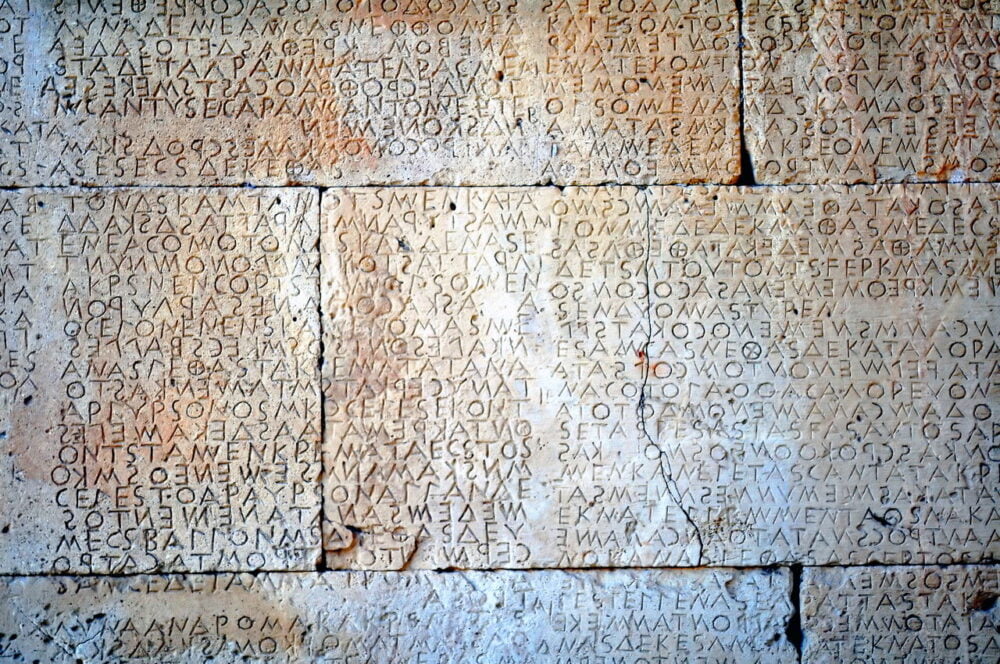Find Places of Interest, Hotels, Apartments, Restaurants, Car Rental and Services in Greece
Find Places of Interest, Hotels, Apartments, Restaurants, Car Rental and Services in Greece
Gortys, The Roman Capital of Crete
Exploring Gortys in Crete: A Journey through History, Myth and Law
Located on the island of Crete, Gortys or Gortyn is an ancient city steeped in history and myth. As a city mentioned in the Homeric poems, it has an illustrious past that stretches back thousands of years.
During the first millennium BC, Gortyn gained prominence over Phaistos, which had been the preeminent city in southern Crete during the Minoan period. Gortyn reached the zenith of its wealth and influence in the Hellenistic period, becoming the most dominant and prosperous city on the island and exercising control over the Messara Valley as far as Levina.
Under Roman rule, Gortyn’s rise continued, culminating in its status as the capital of the united province of Creta et Cyrenaica. After the 4th century, it served as the capital of the independent province of Crete.
Table of Contents

Gortys was a bustling metropolis, home to a thriving civilization that left behind a rich archaeological heritage. Today, it is an archaeological site that provides a fascinating window into the ancient world, inviting visitors to step back in time and explore its historic streets and structures.
Another aspect of Gortys that sets it apart is its association with the Law Code of Gortyn, the oldest and most complete example of ancient Greek law. This significant find provides invaluable insight into the social structure and legal practices of the time. The Gortyn Code is a testament to the advanced civilization that flourished in Gortys and provides a tangible link to the city’s illustrious past.
Geographical Location
Gortys is located in the fertile Mesara Plain in south-central Crete, an area known for its agricultural productivity. This location, coupled with its proximity to the Libyan Sea, made Gortys an important hub of trade and commerce in ancient times.
The city was also strategically located near two ports, Levena and Metallum, which enhanced its importance as a center for maritime activities. These geographical advantages contributed to the growth and prosperity of the city.
Gortys’ location also provided natural defenses, making it a formidable stronghold in times of conflict. The city’s location on the fertile plain, along with its access to the sea, made it an attractive place for settlement. Its natural advantages, combined with its strategic location, played a crucial role in Gortys’ rise to prominence.
How to get to Gortys from Heraklion
- The easiest way to get to Gortyna from Heraklion is by car. It’s about a 45-minute drive south from Heraklion on the main highway. Look for signs directing you to the archaeological site at Agioi Deka.
- You can also take a bus from Heraklion to Ancient Gortys. Buses leave from Heraklion bus station B and get off near the archaeological site. The trip takes about 1 hour.
- A taxi from Heraklion to Ancient Gortys takes about 40 minutes.
- Guided day tours are also available from Heraklion to Ancient Gortys, often combined with other sites such as Phaistos Palace and Matala village. Tours generally depart from hotels in Heraklion.
- When visiting, be sure to see the Roman Odeon, the Gortyn Law Code inscription, the Temple of Apollo, the Praetorium, the Acropolis, and other ruins. The site is open every day.
Gortys, Gortyn, Gortyna or Larissa
In its early history, Gortys was known by the name Larissa, which has its roots in ancient Greek and is believed to mean “citadel” or “fortress”. This name suggests that Gortys was once a fortified city, a stronghold that played an important role in the defense of the region.
History of Gortys
Gortys played a significant role in the history of ancient Greece, marked by alliances, conquests, and cultural advancement. The city had an alliance with Knossos in its early history, signifying its status as a powerful city-state and its influential role in the politics of the region. This alliance sheds light on the diplomatic relations and political alignments of the time.
In its early history, Gortys was known by the name Larissa, which has its roots in ancient Greek and is believed to mean “citadel” or “fortress”. This name suggests that Gortys was once a fortified city, a stronghold that played an important role in the defense of the region.
During the era of the Roman Empire, Gorty’s importance grew exponentially. The city became the capital of Crete and Cyrene, marking a significant shift in its political and cultural standing. Gortys’ status as a capital city was indicative of its power and influence during this period.
Despite its prosperity, the city met a tragic end. In 828 AD, Gortys was destroyed by the Arabs, marking a dark chapter in its history. This event brought an end to its era of prosperity and signaled the beginning of a new phase in its history.

Excavations in Gortys
The archaeological excavations at Gortys have played a crucial role in unearthing the city’s historical treasures. These excavations, which began in the late 19th century and continued until 1940, have revealed various structures, artifacts and inscriptions that provide a wealth of information about the city’s past.
Among the most important finds are the Neolithic settlement, the Roman baths and the theater. These discoveries offer a glimpse into the architectural development of the city and the lifestyle of its inhabitants. Many of the findings from Gortys are displayed in the Heraklion Archaeological Museum, as well as in the new Museum of Messara, where visitors can gain a deeper understanding of the city’s historical and cultural heritage.

Major Attractions and Landmarks in Gortys
The archaeological site of Ancient Gortys in Crete boasts several significant historical landmarks:
- The plane tree of Gortys, associated with the myth of Zeus and Europa, adds a layer of mythological significance to the city’s landscape.
- Odeon: A Roman theater dating from the 1st century B.C. and restored after an earthquake in the 2nd century A.D., it is one of the most intact Roman theaters in Crete. This circular structure with its distinctive arched entrance was a venue for music and dramatic arts.
- Great Inscription of Gortys: Located behind the Odeon, this is the earliest and most comprehensive set of legal inscriptions from ancient Greece, dating back to the 6th century BC. The stone tablets, extending over 600 lines, offer a window into the social and legal framework of ancient Crete.
- Basilica of Saint Titus: An early Byzantine church built in the 7th century AD, it is named after Crete’s first bishop, St. Titus, a companion of St. Paul. Featuring a large apse with adjacent chapels, the basilica was reopened in 2019 after extensive restoration.
- Temple of Apollo Pythios: An archaic temple dating from the 7th century BC, later converted into a church in the 2nd century AD, this sanctuary was dedicated to Apollo and served as an important place of worship. The perimeter of the temple and the base of the main altar are still visible.
- Praetorium: The residence of the Roman governor and the administrative center of the island, dating from the 2nd century AD. Visitors can explore the remains of Roman baths, aqueducts and a nymphaeum nearby.
- Acropolis of Gortyn: A Bronze Age settlement later fortified in the 6th century B.C., its elevated position provides sweeping views of the site and contains remnants of pre-Roman defensive structures.
- Archaeological Museum of Messara: Located within walking distance from the excavation area, this modern museum houses a collection of artifacts from Gortys that contextualize and elucidate the site’s historical narrative. (link)
The Gortyn Code

The Gortyn code is one of the most significant discoveries in Gortys. This code is the oldest and most complete example of ancient Greek law, providing a comprehensive insight into the social and legal structures of the time. The code, inscribed on a massive stone tablet, details various laws relating to civil disputes, family law and property rights, reflecting the sophistication of the legal system in ancient Greece.
The Gortyn Code has contributed greatly to our understanding of ancient Greek law, making it an important part of Gortys’ historical legacy.
Myths of Gortyn
The myth of Europa and Zeus is deeply woven into the cultural fabric of Gortys. According to the myth, Zeus, the king of the gods, transformed himself into a bull and kidnapped Europa, a Phoenician princess. He then brought her to Gortys, where their union resulted in the birth of three sons, Minos, Radamanthys and Sarpedon, who later became the kings of the three Minoan Palaces in Crete. The mention of “Europe” in this myth gives weight to the claim that the civilization of the European continent was born on the island of Crete.
The plane tree of Gortys is said to be the tree under which Zeus and Europa consummated their love. This tree, standing tall amidst the ruins of the city, is a living testament to the city’s mythical past. The story of Zeus and Europa is deeply intertwined with the city’s identity, adding a layer of enchantment to its historic landscape.
Notable People from Gortyna
Gortys (Gortyna in Greek) was the birthplace of several notable people who left their mark on history:
Thaletas, a renowned musician and poet, was born in Gortys. His contributions to music, especially his development of the Dorian mode, made him a significant figure in ancient Greek history. His works continue to be studied by scholars and musicians alike, testifying to his enduring influence.
St. Titus, a disciple of St. Paul, also had ties to Gortys. According to religious texts, he served as the first bishop of Crete and established the Christian community in the region. His life and works had a profound impact on the religious history of Gortys and Crete as a whole.
Another important figure from Gortys is Philip of Gortyna, a philosopher and mathematician. His intellectual contributions add to the rich cultural heritage of Gortys.
Nearby Attractions
In addition to the wonders of Gortys, the surrounding area offers a wealth of attractions worth exploring. The Early Christian Basilica of Mitropolis, with its stunning mosaic floors and historical significance, offers a glimpse into the early Christian period in Crete.
Another attraction is the ancient olive grove of Gortyn. This centuries-old grove of gnarled olive trees offers a quiet retreat for nature lovers and a glimpse into the region’s agricultural heritage.
Both of these attractions, located in close proximity to Gortys, add to the richness of the visitor’s experience, making a trip to this ancient town a truly immersive journey into the past.
Significance of Gortys Today
Today, Gortys is of great importance in the fields of archaeology and history. Its well-preserved ruins, the Gortyn Code, and the rich array of artifacts uncovered during excavations offer valuable insights into ancient Greek law, society, and religious practices. These discoveries have contributed greatly to our understanding of the ancient world, making Gortys an important site for historical research and study.
The city also plays an important role in the tourism industry. Its archaeological site attracts tourists from all over the world, contributing to the local economy and the preservation of its heritage. Gortys, with its compelling blend of history, culture and myth, continues to captivate visitors, offering a unique journey into the past.
- The Island of Crete
- Heraklion
- Rethymno in Crete
- Chania
- Agios Nikolaos
- The Music of Crete
- Myths of Crete
- Bull Leaping in Minoan Crete
- Gortys, the Roman Capital of Crete
- Chrissi Island in Crete
- Eleftherios Venizelos
- Zorba the Greek
- Wind and Solar Energy in Crete
- Skinakas Observatory
- Rock Climbing in Crete
- A Farmer in Elounda
- The Allure of Crete’s 5 S’s
Read more:



